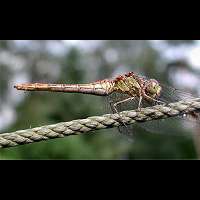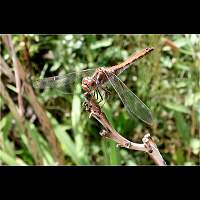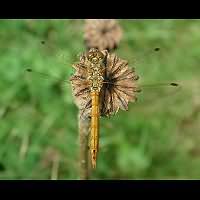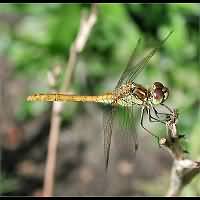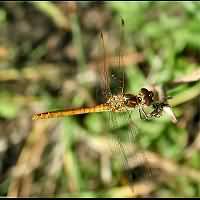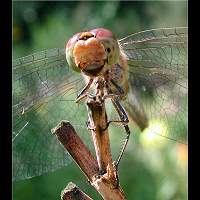[All pictures of garden wildlife on this page are thumbnails. Click on any thumbnail for a large format to be displayed.]
Vagrant Darter (Sympetrum vulgatum)
On the continent are some 10 species of reddish darters. They comprise a group of species hard to identify. The colour does sometimes give some indication, but usually other factors have to be taken into account as well. In Southern Britain the Vagrant Darter is a rare immigrant from continental Europe, but on the continent it is one of the most common species. The Vagrant Darter is very similar to the Common Darter. The main differences being: The Vagrant Darter has legs which are partly black en partly yellowish, the black line on the forehead droops down, the body, especially that of the male, is slightly shaped like a bludgeon and the ovipositor of the female sticks out in a 90 degree angle. In the Common Darter the legs are black, the black line runs over the forehead only and doesn't droop down, the body is straight and the female's ovipositor sticks out in a 40 degrees angle. The Vagrant Darter will reach a length of some 35 to 40mm. The wingspan may vary from 55 to 65mm.
After mating the first eggs are deposited in tandem position. But soon the male lets go of the female. She continues depositing eggs alone, but he's never far away chasing off other males. The eggs are usually laid in the mud in very shallow waters. The larvae live in shallow waters, usually in the mud or among water plants. They are often extremely muddy. Adults always appear after just one year. The Vagrant Darter prefers shallow pools.
The adults migrate over large areas and are often seen in meadows, roads and gardens far away from water. There they usually hunt from a high point. After the attempt to catch a prey, they return to their beloved look-out. Thus they are easily photographed, as you only have to wait a short time for their return.
The animal in the bottom picture may be a Vagrant Darter, but may also be another Darter species alltogether. It is extremely fresh and from this picture a positive id cannot be made.
After mating the first eggs are deposited in tandem position. But soon the male lets go of the female. She continues depositing eggs alone, but he's never far away chasing off other males. The eggs are usually laid in the mud in very shallow waters. The larvae live in shallow waters, usually in the mud or among water plants. They are often extremely muddy. Adults always appear after just one year. The Vagrant Darter prefers shallow pools.
The adults migrate over large areas and are often seen in meadows, roads and gardens far away from water. There they usually hunt from a high point. After the attempt to catch a prey, they return to their beloved look-out. Thus they are easily photographed, as you only have to wait a short time for their return.
The animal in the bottom picture may be a Vagrant Darter, but may also be another Darter species alltogether. It is extremely fresh and from this picture a positive id cannot be made.

© Copyright 1998-2024 gardensafari.net (Hania Berdys)

 English / engels
English / engels  Dutch / nederlands
Dutch / nederlands